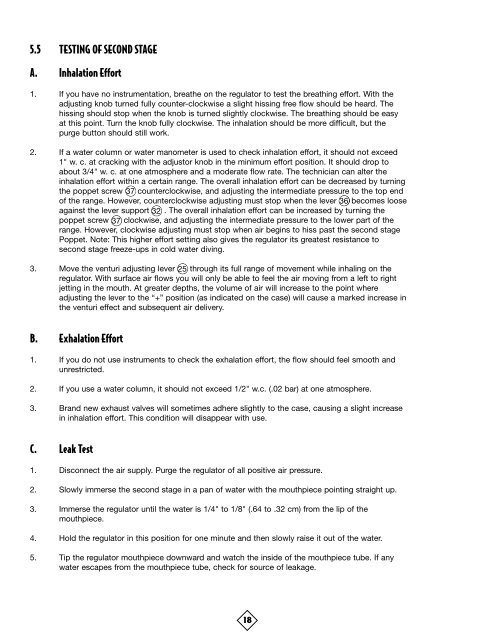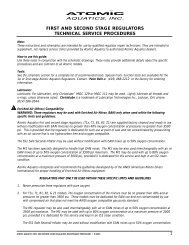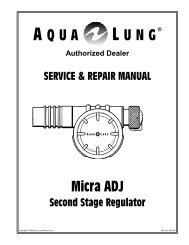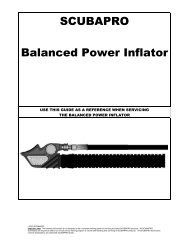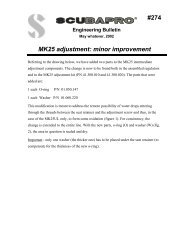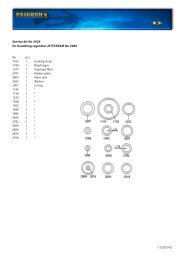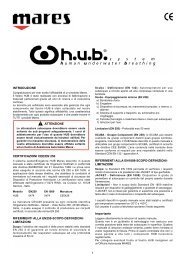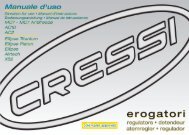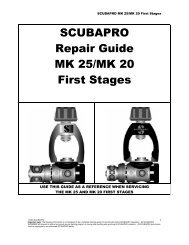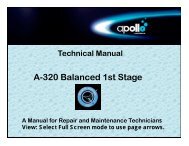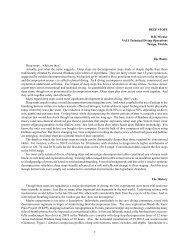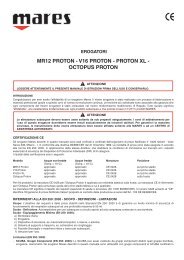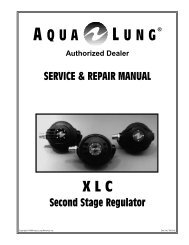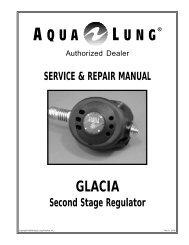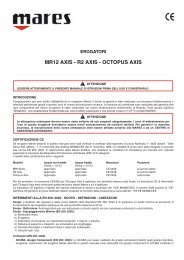SRB5600.pdf1687 KBytes - Frogkick.dk
SRB5600.pdf1687 KBytes - Frogkick.dk
SRB5600.pdf1687 KBytes - Frogkick.dk
You also want an ePaper? Increase the reach of your titles
YUMPU automatically turns print PDFs into web optimized ePapers that Google loves.
5.5 TESTING OF SECOND STAGE<br />
A. Inhalation Effort<br />
1. If you have no instrumentation, breathe on the regulator to test the breathing effort. With the<br />
adjusting knob turned fully counter-clockwise a slight hissing free flow should be heard. The<br />
hissing should stop when the knob is turned slightly clockwise. The breathing should be easy<br />
at this point. Turn the knob fully clockwise. The inhalation should be more difficult, but the<br />
purge button should still work.<br />
2. If a water column or water manometer is used to check inhalation effort, it should not exceed<br />
1" w. c. at cracking with the adjustor knob in the minimum effort position. It should drop to<br />
about 3/4" w. c. at one atmosphere and a moderate flow rate. The technician can alter the<br />
inhalation effort within a certain range. The overall inhalation effort can be decreased by turning<br />
the poppet screw 37 counterclockwise, and adjusting the intermediate pressure to the top end<br />
of the range. However, counterclockwise adjusting must stop when the lever 36 becomes loose<br />
against the lever support 32 . The overall inhalation effort can be increased by turning the<br />
poppet screw 37 clockwise, and adjusting the intermediate pressure to the lower part of the<br />
range. However, clockwise adjusting must stop when air begins to hiss past the second stage<br />
Poppet. Note: This higher effort setting also gives the regulator its greatest resistance to<br />
second stage freeze-ups in cold water diving.<br />
3. Move the venturi adjusting lever 25 through its full range of movement while inhaling on the<br />
regulator. With surface air flows you will only be able to feel the air moving from a left to right<br />
jetting in the mouth. At greater depths, the volume of air will increase to the point where<br />
adjusting the lever to the “+” position (as indicated on the case) will cause a marked increase in<br />
the venturi effect and subsequent air delivery.<br />
B. Exhalation Effort<br />
1. If you do not use instruments to check the exhalation effort, the flow should feel smooth and<br />
unrestricted.<br />
2. If you use a water column, it should not exceed 1/2" w.c. (.02 bar) at one atmosphere.<br />
3. Brand new exhaust valves will sometimes adhere slightly to the case, causing a slight increase<br />
in inhalation effort. This condition will disappear with use.<br />
C. Leak Test<br />
1. Disconnect the air supply. Purge the regulator of all positive air pressure.<br />
2. Slowly immerse the second stage in a pan of water with the mouthpiece pointing straight up.<br />
3. Immerse the regulator until the water is 1/4" to 1/8" (.64 to .32 cm) from the lip of the<br />
mouthpiece.<br />
4. Hold the regulator in this position for one minute and then slowly raise it out of the water.<br />
5. Tip the regulator mouthpiece downward and watch the inside of the mouthpiece tube. If any<br />
water escapes from the mouthpiece tube, check for source of leakage.<br />
18


